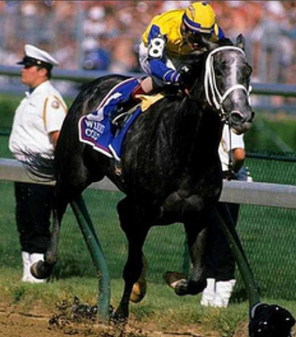I am a huge fan of narrative non-fiction. Such books generally inform, inspire, or entertain. When narrative non-fiction includes each of those three traits, then we’re reading something special that hard to put down. That’s precisely what I found with Mark Paul’s, The Greatest Gambling Story Ever Told. Not only is the book fast-paced and entertaining, but I also enjoyed learning about an industry where I knew nothing.
The Book’s Premise
It’s not often I get to read a page-turner and then get to chat with the author. While we get to hear Mark ‘Miami’ Paul’s longshot future’s bet with a filly named Winning Colors, there are other character arcs included.
Mark goes into detail about what it’s like to own racehorses. Don’t think about it – only a few make money in the business.
Mark goes into detail about horse training and the long hours put in by stall hands.
Need a simple primer on how a gifted horse makes it to the Kentucky Derby? Check. Ditto for learning about the differences between a filly and a mare.
Finally, there’s the analytical thinking of the author and his best friend, Dino. How did they find out about Winning Colors? Why did they place their big bet on her in Mexico instead of Las Vegas? Did they realize the track where they placed their bet was possibly going bankrupt and tied to a drug cartel?
If Mark decides to create a second edition for this book, I have just one recommendation – include an epilogue after this fascinating story. Incidentally, an epilogue is included in the interview with Mark Paul.


Almost One of a Kind
Before winning the Kentucky Derby in 1984, Winning Colors accomplished a feat accomplished only two other times since 1875.
Interesting facts on the day of the race:
- Winning Colors was not the favorite
- Her odds were 3.5 to 1
- Fans bet $41 million on the race, a Derby record at the time
- 150k fans watched the race
- The filly won by the length of her gray head
Interview Highlights
- Can gamblers make money?
- A brief history on Winning Colors
- The billionaire who traded the Chargers for horses (but on the Broncos)
- Would you rather win a Super Bowl or the Kentucky Derby?
- The CEO trainer
- Horses with chiropractors
- On why the interview host loved Luis
- What is futures betting?
- Why Mexico vs Vegas?
- What’s worse, a horsetrack about to go bankrupt or being affiliated with a drug cartel?
- The payout and getting home (alive)
- The business and economics of horseracing
- The mutual fund of horseracing horses
- A feel-good epilogue
The Fleeting Career of a Racehorse
I knew nothing about horseracing before reading this book. I also had no idea how many races they ran annually.
According to Mark Paul, most top horses only race 2 to 4 times at age two. The next year, that volume increases to five to eight races. By year three, they race another five to eight races. Retirement usually occurs in the fourth year.
Given the short career of these horses, what’s the payoff? Mark includes helpful insights in the book by stating that owners generally earn 60 percent of the race’s purse money. They earn 20 percent for second and 10 percent for third. The payout drops to five percent for forth and three percent for fifth. Trainers and jockeys get 10 percent of winning purse money.
I’d love to the financial statements for a horse owner. During the interview, Mark said he didn’t think the owner of Winning Colors made money in the sport. This is a guy shelling out more than $300,000 a month for for training and real estate expenses.
Books Mentioned
I ask every guest about their favorite books. I was not surprised when Mark mentioned Seabiscuit. He pays the author, Laura Hillenbrand, a tribute at the end of his book.

Mark also likes narrative non-fiction. He’s a fan of Michael Lewis. Other titles mentioned included the following:




Other Relevant Links
- Mark’s website
- Bio for speaking engagements

Leave a Reply